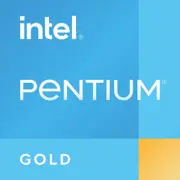Intel Pentium Gold G5500

インテル ペンティアム ゴールド G5500: 基本的なタスク向けの予算プロセッサ
2025年4月
1. 基本仕様: アーキテクチャ、プロセステクノロジー、主要な特徴
インテル ペンティアム ゴールド G5500は、2018年に発売されたプロセッサで、コストパフォーマンスのバランスにより、予算PCの人気の選択肢となっています。
アーキテクチャとプロセステクノロジー
- コードネーム: Coffee Lake (14nm)。
- コア/スレッド: 2コア、4スレッド(ハイパースレッディング)。
- キャッシュ: 4MB L3。
- ベースクロック: 3.8GHz(ターボブーストなし)。
14nmの古いプロセステクノロジーにもかかわらず、このプロセッサはシンプルなタスクにおいて安定したパフォーマンスを示します。ハイパースレッディングにより、二核システムでは負荷の分配が効率的になり、重要です。
統合グラフィックス
- Intel UHD Graphics 630: HDMI/DisplayPort経由で4K@60Hzをサポートし、ビデオのハードウェアデコーディング(H.265、VP9)を行います。
- ゲームパフォーマンス: CS:GOやDota 2のようなゲームでは、フルHDの低設定で30〜40FPSを出します。
ベンチマークテスト
- Geekbench 6: 755(シングルコア)、1496(マルチコア)。
比較として、AMD Athlon 3000Gはそれぞれ~650と~1250を記録します。
2. 互換性のあるマザーボード: ソケットとチップセット
ソケット: LGA 1151-v2(インテルの6世代および7世代のマザーボードとは互換性がありません)。
推奨チップセット:
- H310/B365: 予算向け(ASRock H310CM-HDV, ~$60)。
- B360/B365: USB 3.1 Gen2および多くのPCIeレーンをサポート(ASUS Prime B360M-A, ~$80)。
- Z390: エンスージアスト向けですが、ペンティアムには過剰(Gigabyte Z390 UD, ~$120)。
重要事項:
- 2018年以前に発売されたマザーボードの場合、インストール前にBIOSを更新してください。
- 限定されたVRM電源を持つH310シリーズのチップセットは避けてください。それらはプロセッサのポテンシャルを発揮できません。
3. メモリサポート: DDR4およびデュアルチャネルモード
- メモリタイプ: DDR4-2400(公式データ)、ただし多くのマザーボードは2666MHzまでのオーバークロックを許可します。
- 最大容量: 64GB(実際には8〜16GBで十分です)。
- モード: デュアルチャネルモードのために、必ず2つのモジュールを使用してください(例: 2x4GB)。
例: Crucial DDR4-2400 8GB(2x4GB)キットは約$35です。
4. PSU: 電力計算
TDPが54Wで、専用グラフィックスカードがない場合、300〜400Wの電源ユニットで十分です。
推奨品:
- 基本構成用: EVGA 400 W3 (80+ブロンズ, ~$40)。
- アップグレードに余裕を持たせる場合: Corsair CX450 (450W, ~$55)。
アドバイス: 電源ユニットに節約しないでください。低品質なモデル(例えばApevia)は、コンポーネントに損害を与える可能性があります。
5. ペンティアム ゴールド G5500の長所と短所
長所:
- 価格: ~$60-80(新品)。
- 省エネルギー: コンパクトなケースに適しています。
- UHD 630グラフィックス: オフィスPCのグラフィックスカードの代替。
短所:
- 2コア: マルチタスク能力が限られています(例えば、ストリーミング + ゲームは不可能)。
- 14nm: 10nmのプロセッサに比べて発熱が高いです。
6. 使用シナリオ
オフィスとマルチメディア:
- ドキュメント作成、ブラウジング(20以上のタブ)、Zoom会議。
- VLCやKodiを使用した4Kビデオの再生。
軽いゲーム:
- Minecraft、Among Us、Stardew Valley — 中設定で快適にプレイ可能。
サーバー:
- NASまたは家庭用メディアサーバー(例えば、TrueNASを基にしたもの)。
制約:
- 動画編集(DaVinci Resolve)や3Dレンダリング(Blender)は非常に遅くなります。
7. 競合他社との比較
AMD Athlon 3000G:
- 長所: より安価(約$50)、Vega 3グラフィックス。
- 短所: シングルコアテストでは劣る(約15%)。
インテル セレロン G5905:
- 長所: 価格約$45。
- 短所: ハイパースレッディングなし、3.5GHzのクロック。
結論: ペンティアム ゴールド G5500は、価格と現代技術(4K、DDR4)のサポートのバランスを求める場合に最適です。
8. ビルドのヒント
- クーラー: ボックスのものは十分ですが、静音性を重視する場合はDeepCool GAMMAXX 400(約$20)を選んでください。
- ストレージ: SSDを必ず使用してください(Kingston A400 240GB, ~$25)。
- ケース: Micro-ATX(Fractal Design Core 1100, ~$50)。
ビルド例:
- マザーボード: ASRock H310CM-HDV ($60)。
- メモリ: 8GB DDR4 ($35)。
- PSU: EVGA 400 W3 ($40)。
- 合計: ~$250(ストレージとケースは含まれません)。
9. 最終結論: ペンティアム ゴールド G5500は誰に向いているか?
このプロセッサは以下の用途に適しています:
1. オフィスPC: 信頼性と低エネルギー消費。
2. 家庭用メディアセンター: 4Kビデオ、ストリーミング。
3. 学習用の予算構成: テキスト作成、ブラウジング、軽いアプリケーション。
購入しないべき理由:
- AAAゲームでのプレイを計画している場合。
- プロフェッショナルなタスク(プログラミング、編集)には不適。
2025年の代替案: インテル プロセッサ N100を検討してください(新型、7nm、価格も約$120で高め)。
ペンティアム ゴールド G5500は、年数が経っても依然として需要のある、ノンデマンドユーザー向けの成功した予算解決策の一例です。その強みは、シンプルさ、安定性、ミニマリズムにあります。
基本
CPUの仕様
メモリ仕様
GPUの仕様
その他
ベンチマーク
他のCPUとの比較
ソーシャルメディアで共有する
または当サイトへのリンクを追加
<a href="https://cputronic.com/ja/cpu/intel-pentium-gold-g5500" target="_blank">Intel Pentium Gold G5500</a>